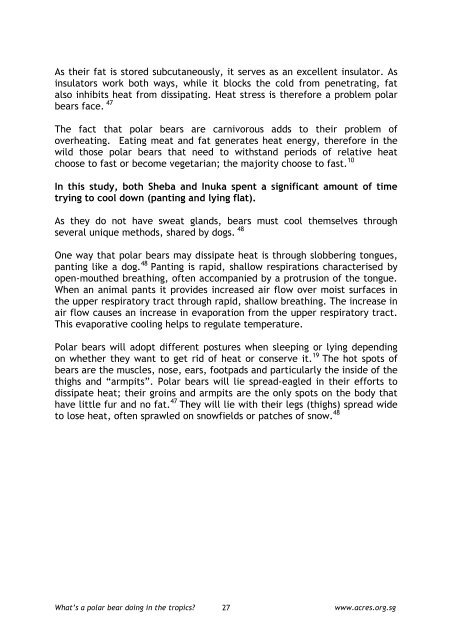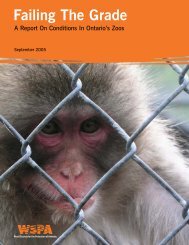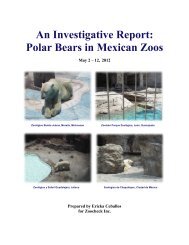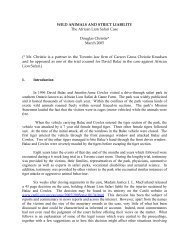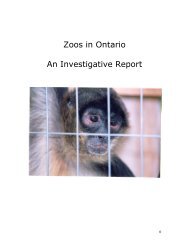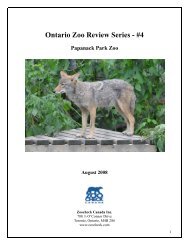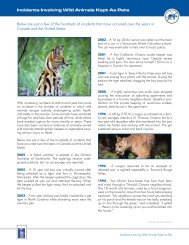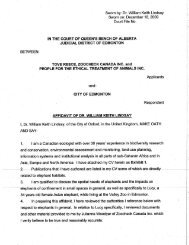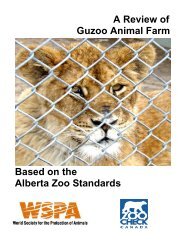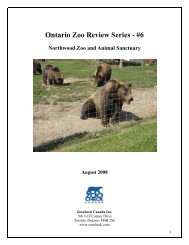What's a Polar Bear Doing in the Tropics? - Animal Concerns ...
What's a Polar Bear Doing in the Tropics? - Animal Concerns ...
What's a Polar Bear Doing in the Tropics? - Animal Concerns ...
You also want an ePaper? Increase the reach of your titles
YUMPU automatically turns print PDFs into web optimized ePapers that Google loves.
As <strong>the</strong>ir fat is stored subcutaneously, it serves as an excellent <strong>in</strong>sulator. As<strong>in</strong>sulators work both ways, while it blocks <strong>the</strong> cold from penetrat<strong>in</strong>g, fatalso <strong>in</strong>hibits heat from dissipat<strong>in</strong>g. Heat stress is <strong>the</strong>refore a problem polarbears face. 47The fact that polar bears are carnivorous adds to <strong>the</strong>ir problem ofoverheat<strong>in</strong>g. Eat<strong>in</strong>g meat and fat generates heat energy, <strong>the</strong>refore <strong>in</strong> <strong>the</strong>wild those polar bears that need to withstand periods of relative heatchoose to fast or become vegetarian; <strong>the</strong> majority choose to fast. 10In this study, both Sheba and Inuka spent a significant amount of timetry<strong>in</strong>g to cool down (pant<strong>in</strong>g and ly<strong>in</strong>g flat).As <strong>the</strong>y do not have sweat glands, bears must cool <strong>the</strong>mselves throughseveral unique methods, shared by dogs. 48One way that polar bears may dissipate heat is through slobber<strong>in</strong>g tongues,pant<strong>in</strong>g like a dog. 48 Pant<strong>in</strong>g is rapid, shallow respirations characterised byopen-mou<strong>the</strong>d breath<strong>in</strong>g, often accompanied by a protrusion of <strong>the</strong> tongue.When an animal pants it provides <strong>in</strong>creased air flow over moist surfaces <strong>in</strong><strong>the</strong> upper respiratory tract through rapid, shallow breath<strong>in</strong>g. The <strong>in</strong>crease <strong>in</strong>air flow causes an <strong>in</strong>crease <strong>in</strong> evaporation from <strong>the</strong> upper respiratory tract.This evaporative cool<strong>in</strong>g helps to regulate temperature.<strong>Polar</strong> bears will adopt different postures when sleep<strong>in</strong>g or ly<strong>in</strong>g depend<strong>in</strong>gon whe<strong>the</strong>r <strong>the</strong>y want to get rid of heat or conserve it. 19 The hot spots ofbears are <strong>the</strong> muscles, nose, ears, footpads and particularly <strong>the</strong> <strong>in</strong>side of <strong>the</strong>thighs and “armpits”. <strong>Polar</strong> bears will lie spread-eagled <strong>in</strong> <strong>the</strong>ir efforts todissipate heat; <strong>the</strong>ir gro<strong>in</strong>s and armpits are <strong>the</strong> only spots on <strong>the</strong> body thathave little fur and no fat. 47 They will lie with <strong>the</strong>ir legs (thighs) spread wideto lose heat, often sprawled on snowfields or patches of snow. 48What’s a polar bear do<strong>in</strong>g <strong>in</strong> <strong>the</strong> tropics?27www.acres.org.sg


